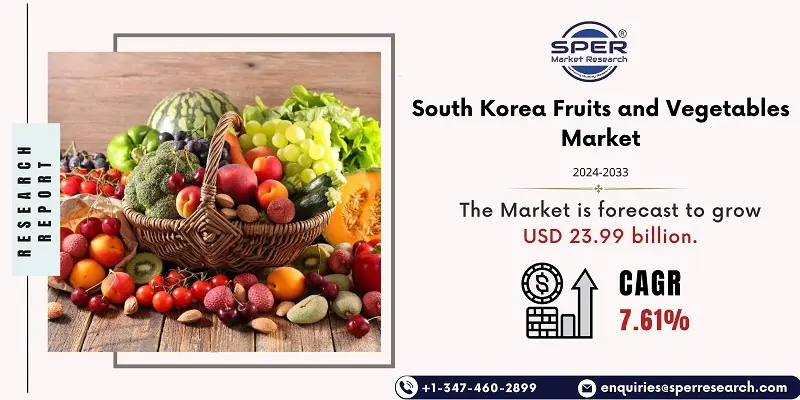
South Korea Fruits and Vegetables Market Growth, Size, Trends, Share, Revenue and Future Outlook
South Korea Fruits and Vegetables Market Size- By Product, By Distribution Channel, By Application- Regional Outlook, Competitive Strategies and Segment Forecast to 2033
| Published: Jul-2024 | Report ID: FOOD2481 | Pages: 1 - 103 | Formats*: |
| Category : Food & Beverages | |||
- January 2023; A new program to boost domestic production of organic fruits and vegetables was unveiled by the Ministry of Agriculture, Food, and Rural Affairs with the goal of promoting sustainable farming techniques and lowering reliance on imports. This program supports research into organic agricultural practices and provides subsidies to organic producers.
- February 2024; In response to the growing demand for unusual and off-season goods, South Korea and Australia struck a trade deal that will facilitate the import of Australian fruits and vegetables. It is anticipated that this agreement will maintain price stability and guarantee a consistent annual supply of superior fruits and vegetables.


| Report Metric | Details |
| Market size available for years | 2020-2033 |
| Base year considered | 2023 |
| Forecast period | 2024-2033 |
| Segments covered | By Product, By Distribution Channel, By Application |
| Regions covered | Northern Region, Southern Region, Western Region, Eastern Region, Central Region |
| Companies Covered | Chung Jung Won Co., Ltd., CJ Freshway Corporation, Daesang FNF Co., Ltd., Hanwha Fresh Co., Ltd., Joy Farm Co., Ltd., Korea Yakult Co., Ltd., Lotte Fresh Farm Co., Ltd., NongHyup Agribusiness Group, Oriental Trading Co., Ltd., Sempio Foods Company, Others. |
- Farmers and Agricultural Producers
- Agribusinesses and Agricultural Cooperatives
- Government Agencies and Regulatory Bodies
- Research Institutions and Academia
- Distributors and Retailers
- Environmental and Sustainability Groups
| By Product: |
|
| By Distribution Channel: |
|
| By Application: |
|
- South Korea Fruits and Vegetables Market Size (FY’2024-FY’2033)
- Overview of South Korea Fruits and Vegetables Market
- Segmentation of South Korea Fruits and Vegetables Market by Product (Fresh Fruits and Vegetables, Frozen Fruits and Vegetables, Dried Fruits and Vegetables)
- Segmentation of South Korea Fruits and Vegetables Market by Distribution Channel (Grocery Stores, Supermarket/Hypermarket, Online, Others)
- Segmentation of South Korea Fruits and Vegetables Market by Application (Raw Eating, Juices, Salads, Preserves and Jams, Others)
- Statistical Snap of South Korea Fruits and Vegetables Market
- Expansion Analysis of South Korea Fruits and Vegetables Market
- Problems and Obstacles in South Korea Fruits and Vegetables Market
- Competitive Landscape in the South Korea Fruits and Vegetables Market
- Impact of COVID-19 and Demonetization on South Korea Fruits and Vegetables Market
- Details on Current Investment in South Korea Fruits and Vegetables Market
- Competitive Analysis of South Korea Fruits and Vegetables Market
- Prominent Players in the South Korea Fruits and Vegetables Market
- SWOT Analysis of South Korea Fruits and Vegetables Market
- South Korea Fruits and Vegetables Market Future Outlook and Projections (FY’2024-FY’2033)
- Recommendations from Analyst
1.1. Scope of the report1.2. Market segment analysis
2.1. Research data source2.1.1. Secondary Data2.1.2. Primary Data2.1.3. SPER’s internal database2.1.4. Premium insight from KOL’s2.2. Market size estimation2.2.1. Top-down and Bottom-up approach2.3. Data triangulation
4.1. Driver, Restraint, Opportunity and Challenges analysis4.1.1. Drivers4.1.2. Restraints4.1.3. Opportunities4.1.4. Challenges4.2. COVID-19 Impacts of the South Korea Fruits and Vegetables Market.
5.1. SWOT Analysis5.1.1. Strengths5.1.2. Weaknesses5.1.3. Opportunities5.1.4. Threats5.2. PESTEL Analysis5.2.1. Political Landscape5.2.2. Economic Landscape5.2.3. Social Landscape5.2.4. Technological Landscape5.2.5. Environmental Landscape5.2.6. Legal Landscape5.3. PORTER’s Five Forces5.3.1. Bargaining power of suppliers5.3.2. Bargaining power of buyers5.3.3. Threat of Substitute5.3.4. Threat of new entrant5.3.5. Competitive rivalry5.4. Heat Map Analysis
6.1. South Korea Fruits and Vegetables Market Manufacturing Base Distribution, Sales Area, Product Type6.2. Mergers & Acquisitions, Partnerships, Product Launch, and Collaboration in South Korea Fruits and Vegetables Market
7.1. South Korea Fruits and Vegetables Market Size, Share and Forecast, By Product, 2020-20267.2. South Korea Fruits and Vegetables Market Size, Share and Forecast, By Product, 2027-20337.3. Fresh Fruits and Vegetables7.4. Frozen Fruits and Vegetables7.5. Dried Fruits and Vegetables
8.1. South Korea Fruits and Vegetables Market Size, Share and Forecast, By Distribution Channel, 2020-20268.2. South Korea Fruits and Vegetables Market Size, Share and Forecast, By Distribution Channel, 2027-20338.3. Grocery Stores8.4. Supermarket/Hypermarkets8.5. Online8.6. Others
9.1. South Korea Fruits and Vegetables Market Size, Share and Forecast, By Application, 2020-20269.2. South Korea Fruits and Vegetables Market Size, Share and Forecast, By Application, 2027-20339.3. Raw Eating9.4. Juices9.5. Salads9.6. Preserves and Jams9.7. Others
10.1. South Korea Fruits and Vegetables Market Size and Market Share
11.1. South Korea Fruits and Vegetables Market Size and Market Share By Region (2020-2026)11.2. South Korea Fruits and Vegetables Market Size and Market Share By Region (2027-2033)11.3. Northern Region11.4. Southern Region11.5. Western Region11.6. Eastern Region11.7. Southern Region
12.1. CHUNG JUNG WON CO12.1.1. Company details12.1.2. Financial outlook12.1.3. Product summary12.1.4. Recent developments12.2. CJ FRESHWAY CORPORATION12.2.1. Company details12.2.2. Financial outlook12.2.3. Product summary12.2.4. Recent developments12.3. DAESANG FNF CO.12.3.1. Company details12.3.2. Financial outlook12.3.3. Product summary12.3.4. Recent developments12.4. HANWHA FRESH CO.12.4.1. Company details12.4.2. Financial outlook12.4.3. Product summary12.4.4. Recent developments12.5. JOY FARM CO12.5.1. Company details12.5.2. Financial outlook12.5.3. Product summary12.5.4. Recent developments12.6. KOREA YAKULT CO.12.6.1. Company details12.6.2. Financial outlook12.6.3. Product summary12.6.4. Recent developments12.7. LOTTE FRESH FARM12.7.1. Company details12.7.2. Financial outlook12.7.3. Product summary12.7.4. Recent developments12.8. NONGHYUP AGRIBUSINESS GROUP12.8.1. Company details12.8.2. Financial outlook12.8.3. Product summary12.8.4. Recent developments12.9. SEMPIO FOODS COMPANY12.9.1. Company details12.9.2. Financial outlook12.9.3. Product summary12.9.4. Recent developments12.10. Others
SPER Market Research’s methodology uses great emphasis on primary research to ensure that the market intelligence insights are up to date, reliable and accurate. Primary interviews are done with players involved in each phase of a supply chain to analyze the market forecasting. The secondary research method is used to help you fully understand how the future markets and the spending patterns look likes.
The report is based on in-depth qualitative and quantitative analysis of the Product Market. The quantitative analysis involves the application of various projection and sampling techniques. The qualitative analysis involves primary interviews, surveys, and vendor briefings. The data gathered as a result of these processes are validated through experts opinion. Our research methodology entails an ideal mixture of primary and secondary initiatives.



Frequently Asked Questions About This Report
PLACE AN ORDER
Year End Discount
Sample Report
Pre-Purchase Inquiry
NEED CUSTOMIZATION?
Request CustomizationCALL OR EMAIL US
100% Secure Payment






Related Reports
Our Global Clients
Our data-driven insights have influenced the strategy of 200+ reputed companies across the globe.




















